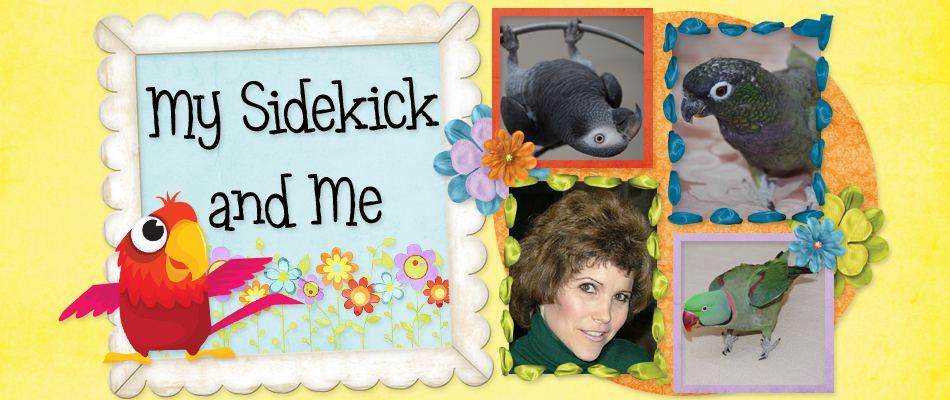Whenever I can, I enjoy sharing what I’ve learned about animal behavior modification using the most positive strategies. This is one of those times.
It was through my parrot behavioral analysis email listserve that I met Jeni Rivett. She is an Arizona-based agility dog trainer, sharing her home with three fully flighted birds and four energetic dogs. I still have one of her posts from years ago when she described how, on cue, all seven of her animals fly or run to their cages. What an amazing site, I remember thinking. When I wrote to her, she described in detail how she taught them.
Jeni, like other trainers with whom I respect and learn from, doesn’t train using ‘pack leader’, dominance-based methods. Although, like so many of us, she did try those other punishment based techniques first. What she and everyone who has ever taught animals (including the human kind) has learned, is that by far, positive reinforcement based training gives her the best results. Behaviors she teaches using positive reinforcement are stronger and done with much more enthusiasm because animals are eager to learn when they are rewarded for their actions. Additionally, teaching in this way serves to build stronger relationships – and that’s something we all want.
Take Sophie for example. The once unhappy dog housed in small quarters of a pet store who later was labeled stupid and stubborn, turned out to be excessively smart when her teacher began using different strategies. The problem - Sophie’s newly adopted mother, that would be Jeni, unwittingly took her to a place that trains police dogs to learn about obedience. They employed practices we’re all too familiar with like jerking the collar. In behavioral terminology, that is called positive punishment, and, as is the danger in using that type of method, Sophie quickly learned to hate training. Can you really blame her?
“I really just thought obedience wasn’t for Sophie,” Jeni said.
There’s a dynamic that happens a lot, Jeni explained. When an animal becomes non-compliant we tend to want to make them do what we want. But when the relationship is adversarial (whether just humans or humans and animals), it just doesn’t work. There are so many possible negative ramifications, aggression and lack of interest are just two.
It was by fluke that Jeni learned about agility training, training that is done with positive reinforcement instead. Suddenly Sophie was catching on, and fast. In two days, that dumb animal had caught on to everything. Everything. It has transformed Jeni’s teaching approach, and as a result, she lives with a house full of really smart companions.
Now Jeni sees her role as more of a team captain and collaborator, rather than a pack leader. “I work really hard to listen to my animals. If I’m having trouble training a behavior, I know there is good reason for it. As the teacher, I look at what I can do better to explain what I want. Maybe I’m not reinforcing my dog for what I want to see more of, maybe my timing is off for providing reinforcement, or maybe I’m asking for too much,” she said.
So, how would someone go about teaching a dog ‘not’ to do what we don’t want – like jumping on the plushy and very expensive sofa in the living room?
“Think about your goals,” Jeni advises. “If I had a dog I didn’t want on my couch, I’d realize he needs a comfortable alternative, otherwise we’d all be sitting on the floor.”
So, first step. Get your dog the most comfortable, plushy pillow or bed you can find and place it in the same room as the sofa you’d rather left to humans. Then get a nice supply of your pet’s all time favorite food or toy treats. Put the treats on the acceptable pillow and when your dog comes over, up the reward with extra human attention. Wow, it doesn’t get much better than that.
Your goal is to make being on that pillow the most totally awesome place to hang out because look at all the reinforcement your friend gets for being there, not to mention it’s sooo soft. Next time you see your dog on your sofa, instead of scolding him (remember punishment is bad for relationships and serves no teaching function), simply ignore him, go to his pillow and have a great time without him, playing with his favorite reward no less. How soon do you think it will be before he ‘chooses’ to go to the pillow instead because he associates it with so much that is positive? You can even put that on cue if you’d like.
Jeni’s dogs never get in trouble for being on her couch, they just get reinforced for being somewhere else. Instead of being punished for doing something wrong, they are rewarded for doing something that is acceptable.
“I’ve found that when I offer plenty of opportunities for reinforcement for everyone, the whole household is a more pleasant place to be,” she said. “There is no such thing as a dumb dog, they just need to be shown what they need to learn. If you can fix the trainer, you can fix the pet.”
NOTE: This was originally published in Hyde Park Living as one of my past Pet Pals columns.
Thursday, June 4, 2009
Don't Want Your Dog One Your Couch? Try 'Teaching' Him Where You'd Rather He Be
Subscribe to:
Post Comments (Atom)












1 comments:
This is a great tip. We just got a puppy and I am sure this is something we'll be dealing with down the road!
Post a Comment